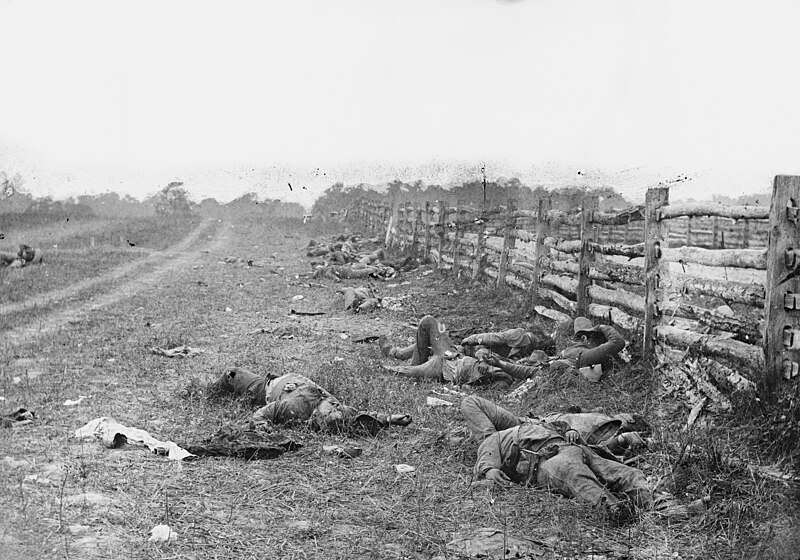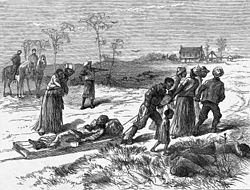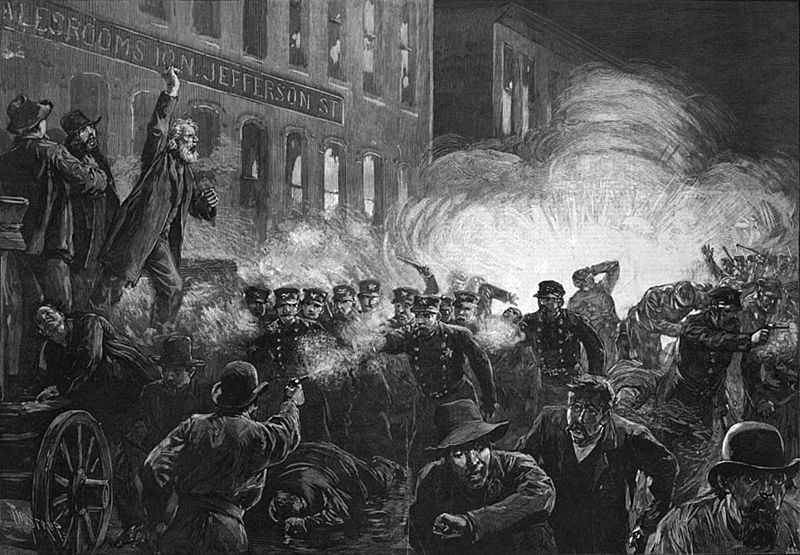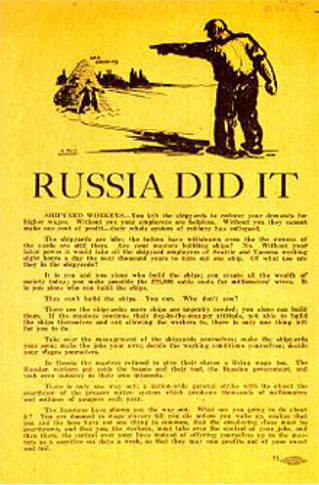Turning Points in
American History
Return to
History
Interne Library
audio course of
Professor E. T. O'Donnell
by
W. Antoniotti
Created 8/11/18 Please link to, use to educate and share.
 summarized
and arranged by
summarized
and arranged by
W.
Antoniotti
from audio course
of
Professor
E. T. O'Donnell
A is when a society takes a new historically significant trajectory creating a new historical reality. It may be marked by the emergence of a new technology and the establishment of a new ideal. The impact may be immediate or develop of time. Editor's Note: These very brief summaries do little justice to the fascinating lectures available from The Great Courses. Consider them for an Internet assignments.
Return to History Interne Library
I am cleaning this up a bit for phone viewing in horizontal mode. 2/18/24

Part 4 Protecting a Divided Nation
22.1 Union Civil War Prospects Turns at 1862 Battle of Antietam
25. A Bloody 1873 Easter Ends of Reconstruction
27. Haymarket Square Marks an 1887 Labor Setback
34.
1919 Red Scare
Begins International Terrorism
See
Terror Episodes Since 1900
1939 Eisenstein's Letter on a Bomb
1948 Berlin Airlift
1969 A Disaster Creates Environmentalism
1989 Russia's Collapse End of Cold War
2001 US Age of Terror Begins
See
Global Populisms and Their Challenges:
the threat and potential solutions for the
rise of global populism
A. Grzymala-Busse, D. Kuo, F. Fukuyama and M. McFaul
Storm Before the Calm
America's Discord, the Coming Crisis of the 2020s,
and then Triumph 1p
by George Friedman
Source 2/25/20
How Democracies Die 4p plus 4 videos
What History Reveals About Our Future
from S. Daniel and D, Ziblatt
The Code of Capital
How the Law Creates Wealth and Inequality
from
K.
Pistor
22. Union Civil War Prospects Turns at 1862 Battle of Antietam
The Union victory at the Battle of Antietam allowed President Lincoln to issue the Emancipation Proclamation. It fundamentally changed the aims of the war. The proclamation all but eliminated the looming threat of English intervention for the Confederacy.
September 1862 Union Confidence was low. Union war efforts were not going well. Their campaign to capture Confederate capital Richmond failed. The Emancipation Proclamation would increase southern pressure but Lincoln was advised to avoid looking desperate and to wait for a Union victory. The Confederacy was brimming with confidence. A major victory over the Union on Northern soil would strengthen Northern Democrats, who might force peace. It could lead the British to intervene on the South's behalf.
Robert E. Lee crossed into Union Maryland on September 4, 1862. He planned to wreak havoc, cause panic and despair and hopefully win a decisive victory. He would meet Union General George B. McClellan at Antietam Creek. The popular McClellan was a superb organizer and motivator, but he was a timid commander with a monumental ego bordering on a messiah complex.
Think General George Patton. McClellan's previous campaigns had failed because of excessive caution. Lee was a superb strategist, a bold commander, and an astute reader of his opponent. His military strategy was offensive-defensive: defensive because of fewer men and arms but offensive in the face of opportunities.
Officers found a copy of Lee’s battle plan allowing McClellan the opportunity to destroy Lee’s army one piece at a time. McClellan arrived on 9/15 with a 3-1 troop advantage. But he delayed 18 hours allowing a Confederate sympathizer in his army to inform Lee who quickly consolidate forces near Antietam Creek. On September 17, McClellan three-pronged assault failed to achieve outright Union victory because of poor battle plan execution and McClellan’s crucial junctures tentativeness.
Lee waited for another McClellan’s attack on September 18. When none came Lee retreated to Virginia. McClellan did not understand that the goal of modern war is to destroy the enemy army, not hold territory. Instead of attacking he wrote to the Army headquarters of a great victory.
Units numbers are from notes accompanying Turning Points in American History audio course of Professor E. T. O'Donnell

War had become horrific. New Quick-reloading rifled muskets and long-range artillery made assaults on fortified trenches tactics suicidal but officers on both sides didn't change tactics. September 17 at Antietam became the deadliest day in U.S. war history with 23,000 day one casualties including one including 3,654 dead. This was four times the allied D-Day casualties. In total, 620,000 Americans died at Antietam.
Antietam was a technical Union
victory because of Lee's retreated. Its significance reached far beyond the
battle field.
First, McClellan was released from command. Better general
would slowly be found
Second, it allowed Lincoln's Emancipation Proclamation.
It transformed the nature of the war from one to restore the Union to one to
end slavery. This greatly diminished chances of British recognition of
Confederate legitimacy. Britain was the world’s advocate of abolition.
Parliament had abolished empire slavery in 1833 and for decades
had fought to end the international slave trade.
Antietam also announced the terrible reality of modern war. Just days after the battle, Mathew Brady and a team of photographers went to the battlefield and took hundreds of pictures. Photographs of bleak and scarred landscapes littered with the broken bodies of soldiers stood in stark contrast to the popular, romanticized visions of war drawn by artists. These photos warned Americans that that the Civil War would be a prolonged conflict, deadlier and more destructive than anyone could have imagined. Editor's Note: Europe did not head the warning given the expectation of a quick WW1 and France ignored technology when building the Marginal Line.

By Alexander Gardner - This image is available from the United States Library of Congress's Prints and Photographs division under the digital ID cwpb.01097.This tag does not indicate the copyright status of the attached work. A normal copyright tag is still required. See Commons: Licensing for more information., Public Domain, https://commons.wikimedia.org/w/index.php?curid=264602
Preview
The aftermath after Apocalypse , Civil War , Reconstruction
Successful early years of Reconstruction did not stop Southern committed to removing federal authority and reemploying white supremacy. In Colfax Louisiana effort intensified when on an Easter Sunday in 1873 about 150 African Americans massacred by white vigilantes. When this elicited no meaningful federal response, reconstruct was doomed. Within a few yeas Reconstruction had been replaced by Jim Crow Laws. Their racially oppressive and exclusion would rule the South for almost 100 years!
The significance of Reconstruction era success from 1865 to 1872 was exemplified when, in 1870, African American minister Hiram Rhodes Revels was elected to the U.S. Senator. Between 1869 and 1901, 22 African Americans would serve as Republicans in the U.S. Congress. PBS Pinchback of Louisiana served as governor and more than 600 freedmen won seats in state and local offices.
Freemen quickly build a vast network of black churches led by black clergymen who would address their spiritual and social needs. These churches quickly running schools and providing charitable community services. By 1870 there were 3,000 southern schools serving 150,000 students
Republican-controlled Southern governments instituted many public works projects, established hospitals and orphanages, and built thousands of schools. They also established more equitable tax codes and passed laws to help indebted farmers keep their land.
Long-term success was hindered by Northern Radical Republicans who had tried to remake the South in a Northern image. Southern states and their elected representatives to Congress were not recognized. A state readmission plan barred most former Confederates from voting and office-holding. Three Reconstruction Amendments hoped to legalize the process

A Bloody 1873 Easter Ends of Reconstruction
Meanwhile, the majority of white Southerners waited for a decrease in federal government commitment to upholding southern equal protection. Grant administration scandals and the Panic of 1873 resulted in legal and illegal resistance to Republican political control.
,_by_Thomas_Nast.jpg/250px-Worse_than_Slavery_(1874),_by_Thomas_Nast.jpg)
White League and
Ku Klux Klan alliance, in illustration, by Thomas Nast, in Harper's Weekly, October 24, 1874 By Harper's Weekly - SourceIn 1872 a Republican federal judge ruled that governor elect William P. Kellogg and the Republican-majority legislature be seated. Backed by a paramilitary, Klan-like organization called the White League, democratic candidate, John McEnery, established a rival New Orleans administration.
Later, in Colfax Louisiana, two Democrats claimed election victory for sheriff and a judgeship. The Kellogg’s administration declared that Republicans had won. A group of armed African Americans guarded the courthouse to keep Republican control. Soon a large force of armed white Democrats led by Christopher Columbus Nash marched on the courthouse. On Easter Sunday, April 13, 1873, Nash ordered the courthouse defenders disband. When they refused, Nash’s men overran the defenders and killed nearly one hundred freedmen. About 50 freedmen fled but were captured and butchered. Federal prosecution convicted a few perpetrators under the Enforcement Act of 1870.

Then, in the landmark Supreme Court case United States v. Cruikshank those convicted of the Colfax Massacre were released. The court ruled that protections of the Fourteenth Amendment only applied to state government actions and not individual actions. Terroristic violence then spread to other Confederate states reaching full development with the organized terror of the Mississippi Plan. Threats, beatings, and killings resulted against anyone daring to vote Republican. One by one the remaining Reconstruction governments fell to a new class of political leaders known as Redeemers . The Jim Crow laws South was born.
Most African Americans would live in rural poverty as sharecroppers mired in a never-ending cycle of poverty and debt. Many private businesses—notably railroads, ferries, and hotels—adopted segregation. States imposed segregation on schools, hospitals and other public facilities. A conservative Supreme Court upheld the so-called Separate But Equal Doctrine. Finally, poll tax and literacy test laws essential banned most blacks from voting. These laws had grandfathered clauses exempting whites.
And Now, The Rest of the Story.
Reconstruction amendments remained part of
the Constitution and would be reinvigorated and honored in the 1950s and
1960s.
27 Haymarket Square
Marks an 1887 Labor Setback
Prelude:
Industrialization created political power, exploitation of workers who joined labor movements to protect from wage cuts, long hours, and unsafe conditions. Denounced as socialist and un-American, many Americans supported unions or remained indifferent.The Haymarket Riot
, which launched pro labor activities which would eventually be called America’s first Red Scare and would stymie efforts to create a national labor party like those in every other industrialized society. The changed was dramatically.America’s first Labor Day on 9/5/ 1882 became a national event by 1886 when President Grover Cleveland signed the holiday into law for all federal workers. The power and unity of organized labor were growing. It grew from a September 5, 1882 New York City celebrate for workers.
The Gilded Age (1870–1900)
was a tumultuous periods rocked by strikes and class conflict. American workers believed monopolists and unscrupulous politicians controlled labor markets to control workers. See Growing an Empire: Wild West to WW1 Congressional committees in 1879, 1883, and 1898 investigated “the relations between labor and capital” and found longer hours, lower wages, and increased worker hostility. Henry George’s Progress and Poverty (1879) argued industrialization brought both greater progress for a few and increased poverty for many. Conservatives argued the greatest danger was a bloody rebellion against the wealthy. In July of 1877 the Great Uprising railroad strike led to 100 deaths and railroad property destruction. Business, editors, clergy, and politicians denounced the radicalism, anarchy, revolution, and violence of the labor movement. Members of the middle and upper classes demonized the poor and demanded that working-class protests be crushed.
By the 1880s the Knights of Labor (KOL)
was
labor's biggest organizer.
Founded in 1869, it decried “the aggression of
aggregated wealth” and called for workers to secure “a proper share of
the wealth that they create.” Skilled and unskilled immigrant and
native-born, white and black, and male and female workers were welcome.
Goals were an eight hour workday, abolition of prison and child labor,
and equal pay for men and women. By 1886 it was the world’s largest
industrial union.
See
A Brief History of American Unions

1887 saw a small but vocal groups of socialists and anarchists ratcheted up radicalism. New York and Chicago anarchists were most active. A 5/1/86 general strike for the eight-hour day drew an estimated 340,000 participants. Peaceful crowds marched in New York City, Detroit, Milwaukee, and Chicago. But May 3 violence broke out when Chicago police attacked workers picketing outside a factory. Their leaders, including some anarchists, called a next night mass meeting. On 5/4 about 3,000 workers gathered in Chicago’s Haymarket Square. Mayor Carter Harrison visited the rally, concluded that the crowd was peaceful, and told the police captain to disperse about 300 Chicago policemen. The captain disobeyed, tried to disperse the crowd, an explosion kill d one patrolman and wounding several a dozen more. Police began firing indiscriminately and clubbing anyone within reach. At least two and as many as six civilians died, along with seven police. Newspapers across the country decried the riot as evidence of a vast and dangerous radical conspiracy. Police began arrested hundreds of suspects. Eight anarchists stood trial—six of them foreign born. The presiding judge was openly hostile to the defendants, and many of the jurors admitted they were prejudiced against the defendants. The prosecution admitted that it had no evidence but argued that the men should be found guilty for spreading dangerous ideas. They were found guilty, and all but one were sentenced to death. Four were hanged, one committed suicide, and the rest were pardoned by a later Illinois governor who destroyed his own career trying to correct the gross miscarriage of justice.
And Now, The Rest of the Story.
The long-term impact of the Haymarket bombing was the failure of American socialism.| Periods | Post WW1 Red Scare of 1919 |
| Prelude |
Early Labor Gains The Uprising of 20,000 lowered work hours to 48 plus overtime, a 1911 fire killed 146 mostly young women and resulted in 8 safety laws, the Ludlow Massacre of 1914 killed 75 and little gain but mine safety improved. |
| Economy | Post WW1 recession,
then better economy. Worker gains were often reversed especially after failure of the 1919 Steel Strike. |
| Causes | Communist International declares world dominance, US Labor Movement joined world-wide populist attempts to increase wages, improved working conditions and limit immigration. |
| Specific Events |
Seattle
General Strike required troops to maintain order during a 5-day city paralysis. Boston Police Strike had State Guard limit damage during two nights of violence. Steel Strike needed National Guard help. Race Riots killed 165+. Anarchist Bombings terrorized two cities. Relevant Videos |
| Government Response |
Nativism
returns-Immigration
Acts-1917 barred Asians,
1918
deportation without
due process, 1921 Emergency Quota Act, 1924 National Origins Act |
| Media Response | Print and Video Coverage was pro-business, against both labor unions and Communists Anarchist. |
| Political Response |
1918 Sedition Act to protect wartime morale by deporting
putatively undesirable foreigners. Palmer Raids had U.S. Attorney General targeting left-leaning Communist labor agitating immigrants by arresting 10,000, jailing 3,500 and deporting 556 resident aliens. "Criminal Syndicalism" state laws outlawing advocacy of violence in effecting and securing social change. Source |
| Winning Oligarchs |
1) Business
protected profit from labor 2) Relegion feared atheism of Communism 3) Right Leaning Politicians 4) Law Justice Department, FBI 5) Media circulation means power/money |
| Class Project | Teacher Sponsored Opened Ended Class Contest. Teachers manage their students as they complete new sections of this page or the same for Turning Points in American History 3 four or five. Videos encouraged. |

34. 1919 Red Scare Begins International Terrorism
Preview: WW 1 ended industrialists immediately began reducing wages and extending hours. This caused record strikes. These big strikes set against the backdrop of the revolutionary Revolution and unsolved U.S. bombings highlight a turbulent year. Together they increased fears of socialism, radicalism and even anarchy and the nation's mood moved dramatically toward conservatism.
Three notable strikes
Large Allied purchases of steel, clothes, and agricultural products caused a U.S. economic boom. Increased labor demand forced union recognition, higher wages, and reduce work hours. Any idea that these labor gains were permanent ended quickly as business quickly rescinded many wartime worker concessions. The result was 3,600 strikes in 1919. They affected 4 million worker.

Seattle
General Strike
required troops to
maintain order during a 5-day
city paralysis.
Boston
Police Strike
had State Guard limit damage during two nights
of violence
.
Steel
Strike
needed National Guard help.
The Russian Bolsheviks Revolution of 3/1919 established
the Communist International to create worldwide. Soon
conspiracy theories hit the United States. Anarchist bombings
added to Americas’ fears. On May Day, n1919 labor activists encountered police
and civilian violence. July had white-on-black racial violence in
Washington DC, Chicago, other major cities. The police did not
intervene. Some in government and many newspapers blamed radicals for
stirring African Americans.
Attorney General A. Mitchell Palmer was the target of two anarchist bombings. He quickly established a General Intelligence Division. It would be headed by a young lawyer named J. Edgar Hoover who compile a list of suspected “reds.” Justice arrested 6,000 mostly union and Socialist Party members. About 500 noncitizens were charged with sedition and deported. Soon labor and radical newspapers faced mob attacks, 30 states passed peacetime sedition laws and 5 legally elected socialist were expelled from the New York state legislature. When a Palmer predicted May Day 1920 major radical uprising did not happened, his presidential ambitions ended. The Republican nominee, Warren G. Harding won with a pledge of returning to “normalcy.”
A Red Scare era of reactionary politics with conservative economic policy would help big business with low taxes and an end to trust-busting regulation. Business worked hard to eliminate trade unions. America’s longstanding fear of government increased dramatically.
Whenever fear gripped the nation fear of immigrants causing radial America. The era's most famous event was the murder trial of Sacco and Vanzetti. A sham trial found them guilty and they were executed. Restricting immigration was aided by a return of the Ku Klux Klan. Enrollment reached 5 million not just in the South members.. Anti-Jewish and anti-Catholic sentiments were added to the Klan's hate repertoire. Annual immigration was limited to 150,000. A racially based quotas system allowing 86%from northern and western Europe. would remain for 41 years.
And Now, The Rest of the Story. The United States had again returned to isolationism. It would continue and by the 1930s, polls indicated most Americans believed World War I participation was a mistake. A 1930's Neutrality Acts significantly delaying U.S. entry into World War II. Americans was appalled by Bill of Rights violations and the era motivated the 1920 formation of the American Civil Liberties Union (ACLU). It would become an influential American political organization.
1939 Eisenstein's Letter on a Bomb
|
Teacher Guided Opened Ended Class Project Contest
Teacher, Principle or Superintendent Should Contact Walter Antoniotti at antonw@ix,netcom.com
Students decide what the project THE PROJECT
PARTS. Project must be approved by some ;local authority
|
1948 Berlin Airlift
1969 A Disaster Creates Environmentalism
1989 Russia's Collapse End of Cold War
2001 US Age of Terror Begins
